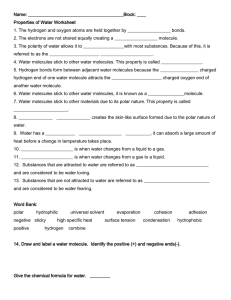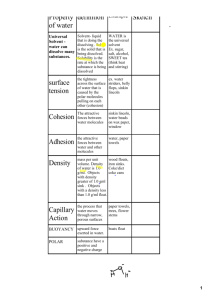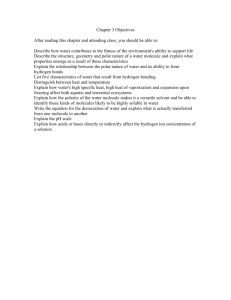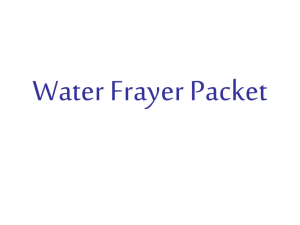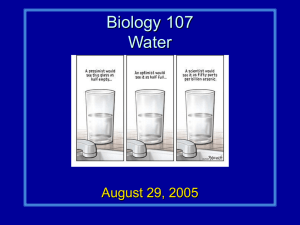Chemistry of Life Post
advertisement
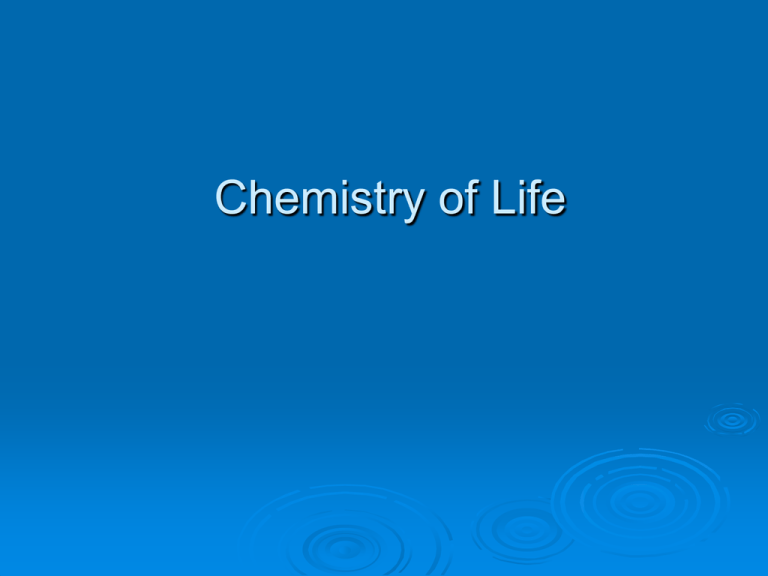
Chemistry of Life Chemistry of Life Outline I. Properties of Water A. Cohesion, Adhesion, and Surface Tension B. Temperature Effects C. Solvent Properties II. Acids and Bases A. Properties B. pH Scale C. Buffers D. Salts Water, Water, Everywhere Of all the common molecules on earth, only water exists as a liquid at the relatively cool temperatures on the earth’s surface ¾ of the earth’s surface is water, 2/3 of the human body is water All organisms require water Water is essential for cell structure and function, water participates in many chemical reactions necessary to sustain life Water is the only common substance to exist in the natural environment in all three physical states of matter-solid liquid and gas Polar Structure of Water Water is a polar molecule: opposite ends of the molecule have opposite charges – – Recall that the oxygen end of the molecule has a partial negative charge while the hydrogens have a partial positive charge Recall this leads to formation of hydrogen bonds between water molecules Water is one of the most polar molecules known Cohesion, Adhesion, and Surface Tension Cohesion: Adhesion: Cohesion and adhesion responsible for Giant Redwoods Surface Tension: Temperature Effects Heat: – KE: energy of motion-atoms and molecules have KE because they are always moving, faster the molecule moves, the more KE it possesses Temperature: Temperature Effects Specific Heat: Water has high specific heat which means it resists changes in temperature (water must gain or lose more heat for temperature to change) Temperature Effects Water has a high heat of vaporization- Water is one of the few substances that are less dense as a solid than as a liquid. Euphausid shrimp under ice Solvent Properties of Water Solvent: Water is not a universal solvent (think oil and water) but it is very versatile Polarity plays an important role in water’s solvent capabilities Solute: Aqueous Solution: Solvent Properties of Water Water can form a hydration shell around some non-ionic molecules too, by surrounding individual molecules and interacting with polar regions of a molecule – E.g. sugar Many different kinds of polar compounds, and ions are dissolved in the water of such biological fluids as blood, the sap of plants, the liquid within all cells Solvent Properties of Water Hydrophilic: Hydrophobic: E.g. mix salad oil with water—shake to break H bonds but as these bonds reform between water molecules, they push the oil molecules out of the way-the oil tends to cluster together in drops or as a layer on the water’s surface-thereby exposing less surface area to the water Acids and Bases When large molecules are put together or pulled apart, hydrogen and/or water is very often involved When a hydrogen is stripped away from a covalent bond it leaves as an ion H+ (called a hydrogen ion), if it is stripped from a water molecule it leaves OH- a hydroxide ion Covalent bonds of water often break spontaneously-ionization – H2O → H+ + OH- Acids and Bases Acid: Base: pH Scale Changes in acidity (or basicity) due to an increase or decrease in hydrogen ions are measured with the pH scale pH scale is used to determine the acidic or basic nature of a solution compared to pure water Pure water has an equal concentration of hydrogen and hydroxide ions pH = 7 Buffers Most cellular functions within the body adapted to narrow pH range around 7 (neutral) Buffers: Salts Salt: – – E.g. NaOH + HCl → NaCl + H2O NaCl remember is an ionic compound which will dissociate in water to Na+ and Cl- Ions – – Most important ions: Na+, Mg2+, Ca2+, K+, ClCa2+ alone is involved in: muscle contraction, cell movements, blood clotting, cell division, nerve function


